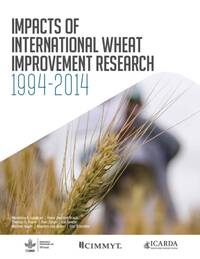Impacts of International Wheat Improvement Research

Authors:
Wheat is a major source of calories and protein for consumers in developing countries. The “Green Revolution” improved the national food security and welfare of the poor in developing countries in the second half of the 20th century. However, investments in crop breeding research have slowed down subsequently, putting pressure on both national and international wheat improvement programs, and wheat productivity increases now lag behind population growth. Continued investments in agricultural innovation and productivity growth are as essential today as in the early years of the Green Revolution (Pingali 2012), particularly as global cereal production must increase by an estimated 56% between 1997 and 2050, with developing countries accounting for 93% of cereal demand growth by 2050 (Rosegrant and
Cline 2003). Since 1990, CIMMYT – the principal center for wheat research of the Consultative Group for International Agricultural Research (CGIAR) – has led three global studies (Byerlee and Moya 1993; Heisey et al. 2002; Lantican et al. 2005) on the impacts of international wheat breeding research in the developing world. These studies showed that:
• The adoption and diffusion of modern wheat varieties continued in the post- Green Revolution era.
• Improved wheat germplasm developed by CIMMYT’s wheat breeding program continued to be used widely by breeding programs in developing countries.
• Public investment in international wheat breeding research continued to produce high rates of return. The present study on the global impacts of improved wheat germplasm updates and expands the data and analyses of the 2002 study and was commissioned and funded by the CIMMYT-led CGIAR Research Program on Wheat.
In line with the previous efforts, this study:
• Examined the use of improved wheat germplasm in the world.
• Documented the contribution of national agricultural research systems, the private sector, and the CGIAR
to international wheat improvement research.
• Estimated the benefits generated by international wheat improvement research and CGIAR investments.
• Was designed to increase awareness about the value of international wheat improvement research.
Following this introduction, Chapter 2 describes analytical methods and the sources and types of data used. Chapter 3 discusses the evolution in bread
wheat improvement and investments in wheat improvement research. Chapter 4 analyzes wheat varietal releases in the world from 1994 to 2014 by origin, wheat type, growing environment, and region. Chapter 5 examines the use
of improved wheat germplasm in the world using similar categories, as well as selected adoption characteristics such as varietal turnover and attributes of adopted varieties. Chapter 6 presents and discusses the estimated research benefits that can be attributed to international wheat improvement efforts and specifically, to CGIAR wheat improvement research. Chapter 7 presents concluding thoughts and discussion.
